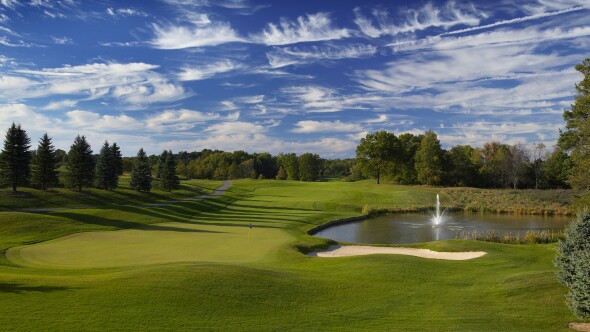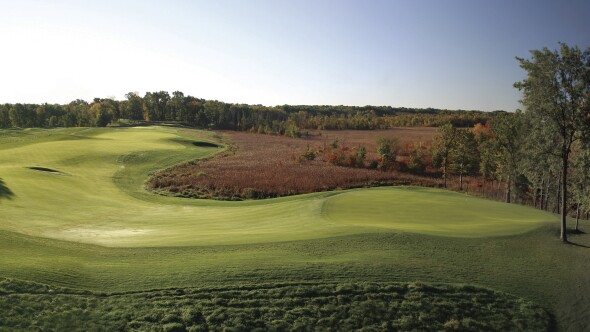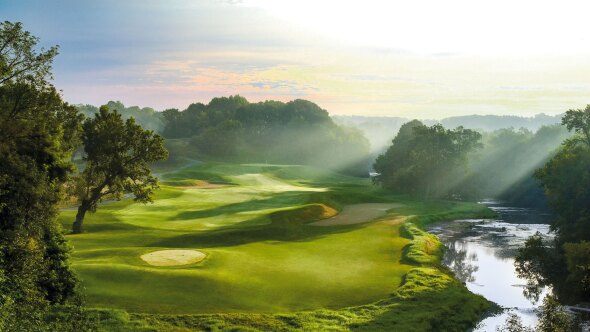Timber Ridge Golf Course

About
Timber Ridge Golf Course was carefully carved from a mature tree nursery that was planted in the 1940s. As a result, the course enjoys more than 60 varieties of trees throughout. The designer, Jerry Matthews, wanted to not only preserve the trees but also work with the existing hills and wetlands so that the course blended seamlessly into the natural environment. The golf course sits atop one of Clinton County's highest elevations, providing a variety of undulations that range from subtle to dramatic. The contours of the landscape determined the placement of the holes and routing of the course. Towering pines and hardwoods frame the holes, giving each one a secluded feel without feeling tight. Timber Ridge Golf Course finishes with a classic and challenging hole that features an undulating, two-tiered green that is fronted by a daunting water hazard.
| Tee | Par | Length | Rating | Slope |
|---|---|---|---|---|
| Black | 72 | 6620 yards | 73.0 | 144 |
| Blue | 72 | 6285 yards | 71.2 | 139 |
| White | 72 | 6010 yards | 70.1 | 135 |
| White (W) | 73 | 6010 yards | 76.2 | 147 |
| Gold (W) | 73 | 5175 yards | 71.4 | 132 |
| Hole | 1 | 2 | 3 | 4 | 5 | 6 | 7 | 8 | 9 | Out | 10 | 11 | 12 | 13 | 14 | 15 | 16 | 17 | 18 | In | Total |
|---|---|---|---|---|---|---|---|---|---|---|---|---|---|---|---|---|---|---|---|---|---|
| Black M: 73.0/144 | 420 | 365 | 375 | 160 | 435 | 545 | 365 | 150 | 530 | 3345 | 430 | 155 | 310 | 380 | 380 | 495 | 165 | 505 | 455 | 3275 | 6620 |
| Blue M: 71.2/139 W: 73.5/136 | 395 | 350 | 330 | 140 | 425 | 525 | 350 | 125 | 515 | 3155 | 405 | 150 | 300 | 365 | 370 | 480 | 155 | 490 | 415 | 3130 | 6285 |
| White M: 70.1/135 W: 72.5/134 | 385 | 335 | 325 | 135 | 410 | 475 | 340 | 120 | 500 | 3025 | 395 | 140 | 285 | 355 | 360 | 465 | 140 | 475 | 370 | 2985 | 6010 |
| Gold W: 71.4/132 | 345 | 280 | 280 | 125 | 335 | 420 | 290 | 100 | 420 | 2595 | 370 | 105 | 270 | 300 | 280 | 365 | 120 | 415 | 355 | 2580 | 5175 |
| Handicap | 7 | 13 | 11 | 15 | 1 | 3 | 9 | 17 | 5 | 12 | 18 | 14 | 10 | 8 | 4 | 16 | 2 | 6 | |||
| Par | 4 | 4 | 4 | 3 | 4 | 5 | 4 | 3 | 5 | 36 | 4 | 3 | 4 | 4 | 4 | 5 | 3 | 5 | 4 | 36 | 72 |
Course Details
Rentals/Services
Practice/Instruction
Policies
Available Facilities
Banquet FacilitiesReviews
Reviewer Photos
-
Photo submitted by Dan7790734 on 10/25/2022
-
Photo submitted by Dan7790734 on 10/25/2022
-
Tap in bird on #11 Photo submitted by Dan7790734 on 10/25/2022
-
Photo submitted by u000004183782 on 08/30/2021
-
Photo submitted by u000004183782 on 08/30/2021
-
+ 1 morePhoto submitted by u000004183782 on 08/30/2021
-
Photo submitted by u000004183782 on 08/30/2021
Great Fall Golf
Had a great time there on an early Sunday for fall golf. Front desk was friendly, starter was friendly, course was in great shape, and price was fair. Will definitely be back again.
Nice course
Only thing is improve is clearer signage to the next hole. Other than that I loved this course very challenging
very nice course
Course is challenging some holes are wide open some are tight. Found the greens to be slower then I like and found them to be inconsistent with speed. Overall its a course I enjoy playing.
Greens are large, undulating, and somewhat quick but not super fast. Nice layout with all four par 3's scenic and challenging. Fair amount of elevation changes.
Fairways are forgiving even though most are cut through the woods. One of the best courses in the Lansing area. Highly recommend.
Getting Better!!
You can tell that the new owners are making a lot of improvements to get the golf course back to what it used to be!! The tee boxes, fairways, and greens are much better than the last time we played. The layout has always been one of our favorites. Pace of play was ok. We will definitely be back!!
Nice Course
First time playing Nice course and challenging layout. Played the Senior Tees and some of the par 4’s were pretty long to be on in 2. The greens were in good shape and challenged your green reading abilities. Used most of the clubs in my bag also All and all it was a great course and a good time! No mosquito problem for us today either. The only negative I would have is that it was a little pricey but the course itself was in pretty good shape to justify it I guess.



























